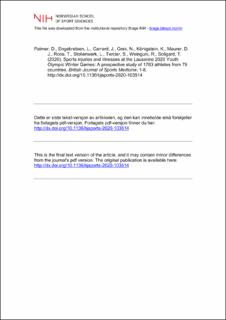| dc.contributor.author | Palmer, Debbie | |
| dc.contributor.author | Engebretsen, Lars | |
| dc.contributor.author | Carrard, Justin | |
| dc.contributor.author | Grek, Natalia | |
| dc.contributor.author | Königstein, Karsten | |
| dc.contributor.author | Maurer, Debbie J | |
| dc.contributor.author | Roos, Thomas | |
| dc.contributor.author | Stollenwerk, Lauren | |
| dc.contributor.author | Tercier, Stephane | |
| dc.contributor.author | Weinguni, Raphael | |
| dc.contributor.author | Soligard, Torbjørn | |
| dc.date.accessioned | 2021-04-28T09:18:06Z | |
| dc.date.available | 2021-04-28T09:18:06Z | |
| dc.date.created | 2021-03-18T12:28:25Z | |
| dc.date.issued | 2020 | |
| dc.identifier.citation | British Journal of Sports Medicine. 2020, 1-8. | en_US |
| dc.identifier.issn | 0306-3674 | |
| dc.identifier.uri | https://hdl.handle.net/11250/2740101 | |
| dc.description | I Brage finner du siste tekst-versjon av artikkelen, og den kan inneholde ubetydelige forskjeller fra forlagets pdf-versjon. Forlagets pdf-versjon finner du på bjsm.bmj.com / In Brage you'll find the final text version of the article, and it may contain insignificant differences from the journal's pdf version. The original publication is available at bjsm.bmj.com | en_US |
| dc.description.abstract | Objective: To describe the injury and illness characteristics among participating athletes during the Lausanne 2020 Youth Olympic Winter Games (YOG 2020), 9–22 January 2020. Methods: The daily number of athlete injuries and illnesses were recorded (1) through the reporting of all National Olympic Committee (NOC) medical teams and (2) in the polyclinic and medical venues by the Lausanne 2020 medical staff. Results: In total, 1783 athletes from 79 NOCs were observed. NOC and Lausanne 2020 medical staff reported 228 injuries and 167 illnesses, equating 11.7 injuries and 8.6 illnesses per 100 athletes over the 14-day period. Injury incidence was highest for snowboard slopestyle (39%), bobsleigh (36%), snowboard big air (29%), ski slopestyle (29%), snowboard cross (24%) and ski cross (21%), and lowest for speed skating, snowboard halfpipe and curling (2%–4%). The highest incidence of illness was recorded for curling (21%), ski mountaineering (15%), snowboard halfpipe (13%), bobsleigh (11%), cross-country skiing (10%) and figure skating (10%). Almost one-third of injuries were expected to result in time loss and 17% of illnesses. Most injuries occurred to the knee (12%) and head (11%), and 64% of illnesses affected the respiratory system. Overall, women suffered more injuries and illness than males. Conclusion: Overall, injury and illness rates were similar compared with recent YOG. While the rate and characteristics of injury and illness varied between sports, consistent patterns across YOG are emerging. If addressed, changes in highlighted areas of risk could have a positive impact on the health and well-being of these young athletes. | en_US |
| dc.language.iso | eng | en_US |
| dc.subject | athlete | en_US |
| dc.subject | illness | en_US |
| dc.subject | injury | en_US |
| dc.subject | injury prevention | en_US |
| dc.subject | sport | en_US |
| dc.title | Sports injuries and illnesses at the Lausanne 2020 Youth Olympic Winter Games: A prospective study of 1783 athletes from 79 countries | en_US |
| dc.type | Peer reviewed | en_US |
| dc.type | Journal article | en_US |
| dc.description.version | acceptedVersion | en_US |
| dc.source.pagenumber | 8 | en_US |
| dc.source.journal | British Journal of Sports Medicine | en_US |
| dc.identifier.doi | 10.1136/bjsports-2020-103514 | |
| dc.identifier.cristin | 1898989 | |
| dc.description.localcode | Institutt for idrettsmedisinske fag / Department of Sports Medicine | en_US |
| cristin.ispublished | true | |
| cristin.fulltext | postprint | |
| cristin.qualitycode | 2 | |
